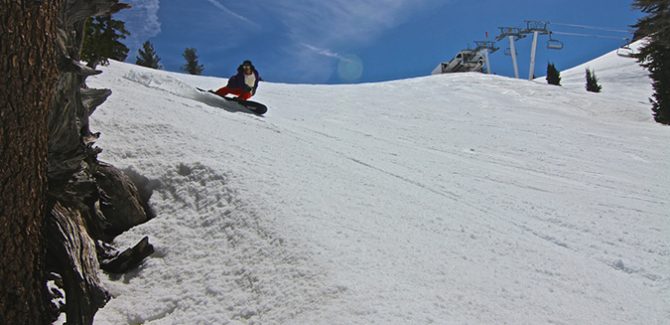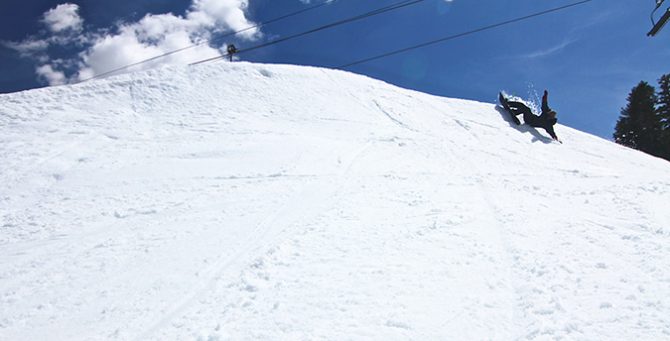
Noaya Wada loves Squaw Valley. Photos: Trevor Husted
Two weeks ago my life changed for the better. As an avid surfer and snowboarder, I was introduced to a style of snowboarding known as snow surfing – a technique that takes the idea of surfing on water to the snow.
Essentially snowboarding started with designs that complimented aspects of surfing. The movement was strong in North America, Europe as well in Japan; a place where it still is one of the more popular styles of riding. So when I heard of an eclectic mix of Japanese riders who practiced this art form were coming to Squaw Valley on their way to a contest at Bachelor, I made it a point to meet up with them and get a glimpse of a brand of riding that had somewhat disappeared from the American snowboard scene.
Two years ago I remember seeing this concept of snow surfing on a trip to Japan. Japanese riders hiking into the hills with short, swallow tailed boards. The pioneers of snowboarding used this technique when snowboarding developed from the snurfer and advanced to the bright neon suits and headbands of the 1970’s and 80’s with the surfstick to go along. The movement was flashy and it made a statement. Companies like Sims, Burton, and Apocalypse, among others, were creating boards that shifted winter sports forever. Small and large directional matchsticks with swallow tails, tipped-shaped noses, and those wiggly bright colored graphics that seemed to jump out and say ‘ride me.’

Wada and his Japanese friends have kept the art alive.
The time for experimentation and innovation had arrived. But as the sport progressed, these boards lost their ‘coolness.’ Riders started pushing the industry towards a rounded nose and tail design, and manufacturers began to move away from the flat camber feel to aspects like Lib Tech’s development of magna traction while other companies created a bottom base of reverse camber and rocker, giving riders the ability to flow through turns. The action sport that mimicked surfing was moving towards a more skate-oriented ethos. The revolution that saw rebellion, the punks, and a rule breaker status had begun to mature and it wasn’t necessarily just about the turn anymore—freestyle snowboarding had captured the general public’s attention.
But snowboarding had lost a unique piece of its soul. Small, fish-shaped boards brought out the surfing in snowboarding or what some would call “snow surfing.” The feel of riding an endless wave of snow, much like the feeling of an endless flowing wave. Not to mention the effect that powder could bring to the whole sensation. A seemingly playful, fun aspect of shredding that didn’t result in crazy wipeouts or air had come and gone in the States. But in Japan it never really left. The community stuck strong to the art of riding the snow like a wave. The real art that started in the early 70’s with producers like Moss, the original snow surf maker and later in 1998, Gentemstick, whose production established a market based on a playful board pushing the limits of terrain, adding an element of creativity to the riding, and addressing attributes of surfing the snow. Boards that were carefully crafted by hand to support the full snow surf vision and help to define the Japanese snowboarding demographic.

Teppei Hirota getting kind of nasty with the layback.
This is what I experienced with a team of five riders from the northern island of Hokkaido – two of which represented the Moss Snowboard Team. The spring sun was in full effect at Squaw Valley, California and they’d brought me a Moss Snowstick board, the company’s founder, Shinzo Tanuma’s, original prototype in 1971. It’s still their top selling board.
It looks like a flat, white banana with the tail cut off; at 151 cm it’s shorter than my normal 158-size board with a tapered shape, a directional camber and a slimmer tail. The craftsmanship is superb and as I slapped my bindings on I got excited. Would I even know how to ride this thing? The first turns were scrappy and I fought with gravity to find the right edge pressure without bucking myself to the ground. My legs warmed up and I began to feel the flow. It really was like surfing! I could pump my legs to get momentum. And the riders inspired me. They moved like a circus parade, a caravan of troubadours using the mountain for composition. Their ability to read the terrain was calculated to the point. I had always had an intrigue for this style and the way the Japanese seemed to master it. But on this day I had the full effect unfold right before me: positioning their boards underneath them in a sitting, cutback motion then popping up, sliding off the hillside using their hands for stability and the speed of the turn to defy gravity, then nearly skimming their chest against the snow with big, beefy s-turns.

Wada, buttering it out.
Teppei Hirota, a Moss rider for 20 years is reserved and shy. But his riding does all the talking as he carved his way down the slope effortlessly. Naoya Wada also rides for the Moss team. Noaya is more animated. He wore a bright purple jacket and hid from the sun under his black bucket hat as he gave me the low down on snow surfing. “Powder is the best,” he tells me “but mellow groomers pave way for the best slashes.” This statement is contrary to my belief that it should always be about the steeps with snowboarding.
Most of this group of Japanese riders belong to a group known as the Niseko Downchill, a mix of Hokkaido snow surfers dedicated to keeping the turn a beautiful and deliberately designed skill. They loved the natural features at Squaw. “Surface-style spins and butters,” Teppei says, as he describes the spirited method of riding and determining what natural features to expose. Butters are ground tricks on a snowboard that involve pressing the nose or tail to the snow while moving and adding one’s own variations. Half pipes, banked slaloms, gigantic vertical pool-like bowls, berms and the side entrance to kickers made for an awesome canvas.

The Moss Swallow tail and Moss Snowstick.
As this style remerges it seems as if resorts are starting to curtail designs to accommodate snow surfing. You can just imagine a large smooth rolling skate park. While in North America, Mount Baker has kept the tradition alive with its banked slalom, resorts like Mammoth have a hardworking park crew and dedicated network of riders intricately shape the park for a creative flow event that is known as Holy Bowly—only friendly competition and fun there. In the Tahoe area, the Rally for Rocker, a banked slalom event on Donner Summit every year for the past three with a community of riders building and designing the course. One of the more notable, and quite possibly the only, snow surf style competitions was designed by surf icon Gerry Lopez at Mt. Bachelor in Oregon.
The Big Wave Challenge was set up like a surf contest with one long line of shifting berms and mixed wall sizes designed to depict real waves. Yo Amagai, a flashy K2 rider who was with us that day at Squaw ended up first in the 40 and over division at Bachelor’s Big Wave Challenge.
Amidst this core group of riders there is a devout connection to this unique style of riding that has been somewhat engrained into their selected community. And thankfully, it’s making a comeback here, too.

